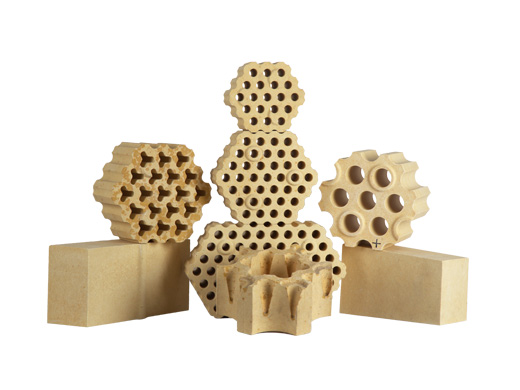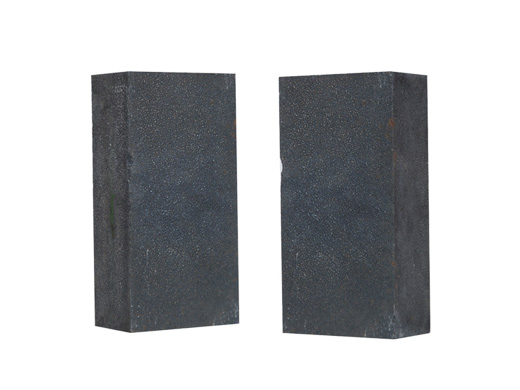To explore the application of magnesia carbon brick in refractory materials
Industry news | Refractory Wiki | Refractory news | Enterprise news |Introduce

Magnesia-carbon brick, also known as magnesia-carbon brick, is a kind of refractory material widely used in various industries. Made from a mixture of magnesium oxide (MgO) and carbon (C), these bricks have a unique combination of properties that are suitable to withstand high temperatures and chemical corrosion, and are essential components in high-temperature industrial applications. Its unique combination of high temperature resistance, chemical erosion resistance and thermal conductivity makes it an invaluable tool for ensuring the life and efficiency of equipment in various industries.
The raw materials for magnesia carbon bricks
The production of magnesia carbon bricks requires specific raw materials that are carefully chosen for their properties. The main raw materials used in the manufacturing process include magnesia (MgO) and carbon (C), along with other additives.
Magnesia, which is the primary component, is sourced from natural magnesite or magnesite ore. The magnesite ore undergoes a refining process to extract the pure magnesia that is essential for the production of these bricks. The quality and purity of the magnesia directly impact the performance of the final product.
Carbon, another critical ingredient, comes from various sources such as anthracite coal, petroleum coke, and natural graphite. The carbon content in magnesia carbon bricks contributes to their high temperature resistance and thermal conductivity. The selection of the carbon source plays a significant role in determining the final characteristics of the bricks.
In addition to magnesia and carbon, certain additives and binders are included in the raw material mixture. These additives can include antioxidants, resins, and metallic powders. These additives help improve the overall properties and performance of the magnesia carbon bricks.
Overall, the raw materials used in magnesia carbon brick production are carefully selected to ensure the desired properties and performance of the final product. The combination of magnesia, carbon, and other additives creates a durable and heat-resistant material that finds extensive use in various industries.
The melting point of magnesia carbon brick
The melting point of magnesia-carbon brick is an important characteristic that determines its high temperature resistance. The melting point is the temperature at which a material changes from a solid state to a liquid state.
Magnesium-carbon bricks have excellent heat resistance, enabling them to withstand extreme temperatures without losing their structural integrity. The melting point of magnesium-carbon bricks is usually between 2800°C and 3200°C(5072°F and 5792°F), depending on the specific composition and quality of the brick.
This high melting point makes magnesia-carbon bricks suitable for industrial applications where extreme temperatures are encountered. It can withstand the intense heat generated in steel-making processes, electric arc furnaces and other high-temperature environments.
Magnesium-carbon bricks remain solid at such high temperatures, providing reliable protection for industrial equipment and structures. Its ability to withstand molten metal, alkali and chemical attack is essential to ensure the safety and efficiency of various industrial operations.
In conclusion, magnesia-carbon bricks have a very high melting point, between 2800°C and 3200°C (5072°F and 5792°F). This exceptional heat resistance enables bricks to withstand extreme temperatures in demanding industrial applications, making them a valuable material for maintaining the integrity and longevity of equipment and structures.
The thermal conductivity of magnesia carbon bricks
The thermal conductivity of magnesia-carbon brick is the key characteristic that determines its effective heat transfer ability. Thermal conductivity refers to the ability of a material to conduct heat through its structure.
Magnesium-carbon bricks are known for their excellent thermal conductivity, allowing them to dissipate heat quickly and efficiently. These bricks can effectively transfer heat from the high temperature area to the cooler area, ensuring a uniform temperature distribution within the industrial equipment.
The high thermal conductivity of magnesia carbon bricks makes them widely used in steelmaking, foundries and non-ferrous metal production industries. In steelmaking, these bricks help maintain a consistent temperature throughout the furnace, promoting an efficient and controlled melting and refining process.
In addition, the superior thermal conductivity of magnesia-carbon bricks enhances their performance in applications requiring insulation. By effectively dissipating heat, these bricks prevent excessive heat buildup and reduce the risk of thermal damage to surrounding structures and equipment.
All in all, magnesia-carbon bricks have excellent thermal conductivity, enabling efficient heat transfer and temperature control. Their ability to rapidly distribute heat makes them essential in industries that require precise thermal management, thereby improving the overall performance and safety of industrial processes.
The advantages of magnesia carbon bricks
Magnesia carbon (MgO-C) bricks offer several advantages that make them highly desirable in various industrial applications. Here are some key advantages:
High Temperature Resistance: Magnesia carbon bricks exhibit exceptional resistance to high temperatures, allowing them to withstand extreme heat conditions without significant deterioration. They can maintain their structural integrity at temperatures ranging from 2800°C to 3200°C (5072°F to 5792°F), making them suitable for use in industries that involve intense heat, such as steelmaking and foundries.
Excellent Thermal Shock Resistance: Thermal shock refers to rapid temperature changes, which can cause materials to crack or break. Magnesia carbon bricks are designed to withstand thermal shock effectively, enabling them to endure rapid heating and cooling cycles without sustaining damage. This property is vital in industries where frequent temperature fluctuations occur.
Good Chemical Erosion Resistance: Magnesia carbon bricks possess excellent resistance to chemical erosion, ensuring their longevity and reliability even when exposed to corrosive substances and molten metals. This resistance makes them ideal for applications in non-ferrous metals production, cement manufacturing, glass production, and other industries where contact with chemically aggressive materials is common.
Low Spalling and Penetration: Spalling refers to the breaking or flaking of brick surfaces due to thermal stress or repeated heating and cooling cycles. Magnesia carbon bricks have low spalling tendencies, meaning they are less prone to surface deterioration and fragmentation. Additionally, they have low penetration rates, minimizing the infiltration of molten slag and metal into the brick structure.
Improved Slag Resistance: Slag is a byproduct of certain industrial processes and can erode refractory materials over time. Magnesia carbon bricks' composition and design provide improved slag resistance compared to other refractory materials, extending their service life and reducing maintenance and replacement costs.
Enhanced Mechanical Strength: Magnesia carbon bricks exhibit good mechanical strength, enabling them to withstand mechanical stress and load-bearing requirements. This property ensures their durability in industrial environments with heavy equipment and mechanical impacts.
In summary, the advantages of magnesia carbon bricks include high temperature resistance, excellent thermal shock resistance, good chemical erosion resistance, low spalling and penetration tendencies, improved slag resistance, and enhanced mechanical strength. These advantages collectively make them a preferred choice for industries that rely on durable and reliable refractory materials.
What is magnesia carbon brick used for?
One of the primary applications of magnesia carbon bricks is in the steel industry. They are extensively used in the construction of steel ladles, converters, electric arc furnaces, and other equipment involved in the steelmaking process. These bricks provide excellent resistance to high temperatures, making them ideal for lining furnace walls and protecting against heat.
In foundries, magnesia carbon bricks are utilized for lining crucibles, molds, and other equipment involved in metal casting. Their ability to withstand extreme temperatures and resist chemical erosion ensures the longevity and reliability of these critical components.
Magnesia carbon bricks are also commonly employed in non-ferrous metals production. They are used in smelting and refining processes, where they come into contact with corrosive substances and molten metals. The high resistance of these bricks to alkalis and slags makes them indispensable for maintaining the integrity of equipment in such harsh environments.
Moreover, magnesia carbon bricks find applications in various other industries where heat resistance and chemical erosion resistance are crucial. These include industries such as cement manufacturing, glass production, and petrochemical processing.
In summary, magnesia carbon bricks are versatile materials with multiple industrial applications. Their high temperature resistance, chemical erosion resistance, and durability make them invaluable in the steel, foundry, and non-ferrous metals industries, as well as in other sectors that require reliable and long-lasting refractory solutions.
Newest
- 2023-07-31
Properties of silicon nitride and its application in refract···...
- 2023-07-31
Properties of silicon nitride and its application in refract···...
- 2023-07-31
Properties of silicon nitride and its application in refract···...
- 2023-07-31
Properties of silicon nitride and its application in refract···...
- 2023-07-31
To explore the application of magnesia carbon brick in refra···...
Solution
- 2022-11-22
The technical requirements and production processes of fused···...
- 2022-09-06
Price Determinants of high alumina fire bricks...
- 2022-08-30
Technical performance and technology of silica mullite brick···...
- 2022-08-27
Refractory materials in various parts of the furnace and pre···...
- 2022-08-23
Magnesite chrome brick composition process classification...




